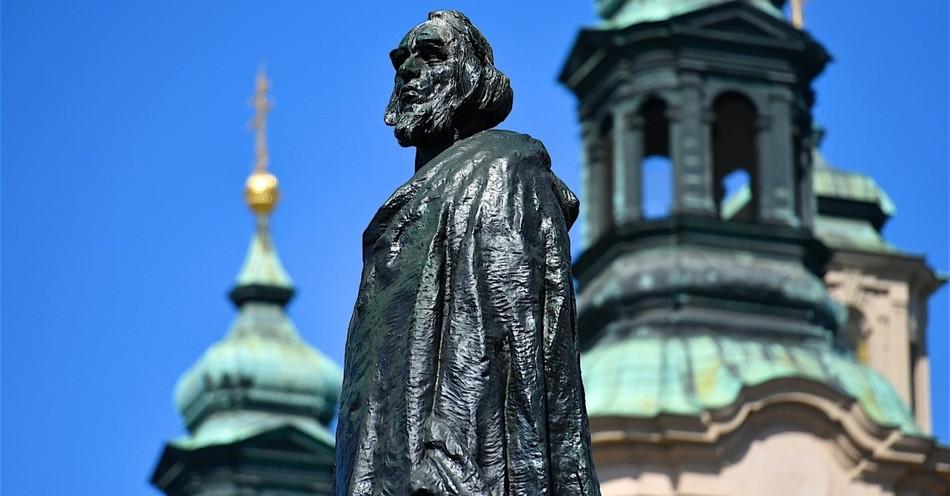"We'll cook his goose." Believe it or not, that phrase originated as a reference to a man whose last name means (in his native language, Czech) "goose" - John Hus. He was literally cooked - burned at the stake - but in being cooked he lit a fire of both nationalism and church reform.
John - Jan in Czech - was born in 1374 to a humble family. He was ordained as priest in 1401 and spent much of his career teaching at the Charles University in Prague, Bohemia (in what is now Czechoslovakia). He was also the preacher at the Bethlehem Chapel in Prague. (Don't let "chapel" mislead you. Three thousand people packed in to hear his sermons.)
Wycliffe's works
The reform-centered writings of John Wycliffe found their way into Bohemia. Studying in the days before the printing press, Hus painstakingly copied Wycliffe's books for his own use. Like Wycliffe, Hus emphasized personal piety and purity of life. He stressed the role of the Bible as authority in the church, and consequently, he lifted biblical preaching to an important status in church services.
Bethlehem Chapel itself was a tangible illustration of Hus's teachings. On its walls were paintings contrasting the behavior of the popes and Christ. For example, the pope rode a horse while Christ walked barefoot, and Jesus washed the disciples' feet while the pope had his feet kissed. Many of the clergy felt-rightly-that their lifestyle was being questioned. But Hus was popular with the masses and with some of the aristocracy, including the queen.
Thrown out of church
The archbishop of Prague told Hus to stop preaching and asked the university to burn Wycliffe's writings. Hus refused to comply, and the archbishop condemned him. Meanwhile, Hus preached against the sale of indulgences, which were being used to finance the pope's expedition against the king of Naples. The pope excommunicated Hus and placed Prague under an interdict-roughly meaning that the entire city was excommunicated and could not receive the sacraments. To relieve this situation, Hus left Prague, but he continued to preach in various churches and in the open air. And, like Jesus, "the common people heard him gladly."
Questions of authority
Why was the hierarchy so opposed to Hus? Not only did he denounce the often immoral and extravagant lifestyles of the clergy (including the pope himself), but he also made the bold claim that Christ alone is head of the church. In his book On the Church he defended the authority of the clergy but claimed that God alone can forgive sins. He also claimed that no pope or bishop could establish doctrine contrary to the Bible, nor could any true Christian obey a clergyman's order if it was plainly wrong.
Hus could only meet with trouble for such teachings. In 1415 he was summoned to the Council of Constance to defend his teachings. In being conducted there he was victim of one of the dirtiest tricks ever played on a Christian. He was promised safe conduct by the Emperor Sigismund. And he had the papal assurance: "Even if he had killed my own brother . . . he must be safe while he is at Constance." Yet, Hus was arrested soon after he arrived. He was confined in a cell under a Dominican convent. His cell was right next to a sewer system. In effect, the Council had already made up its mind about this rebel Hus. The Council condemned the teachings of Wycliffe, and Hus was condemned for supporting those teachings. Especially under fire was Hus's statement that when a pope or bishop is in mortal sin he has ceased to be pope or bishop.
A chapel full of gold
Hus, sick and physically wasted by long imprisonment, illness, and lack of sleep, protested his innocence and refused to renounce his alleged errors unless he could be shown otherwise from Scripture. To the council he said, "I would not, for a chapel full of gold, recede from the truth."
"I will gladly die"
Formally condemned, he was handed over to the secular authorities to be burned at the stake on July 6, 1415. On the way to the place of execution, he passed a churchyard and saw a bonfire of his books. He laughed and told the bystanders not to believe the lies circulated about him. Arriving at the place of execution, he was asked by the empire's marshal if he would finally retract his views. Hus replied, "God is my witness that the evidence against me is false. I have never thought nor preached except with the one intention of winning men, if possible, from their sins. Today I will gladly die." The fire was lit. As the flames engulfed him, Hus began to sing in Latin a Christian chant: "Christ, Thou Son of the Living God, have mercy upon me."
A movement continues
Hus had long been popular with the lay people, and his heroic death only increased his prestige. His followers came out in open rebellion, both against the Catholic church and against the German-dominated empire with which they wanted no part. Despite repeated efforts of popes and rulers to stamp out the movement, it survived as an independent church, known as the Unitas Fratrum or the Unity of the Brethren.
Not about to listen to a "rebel"
The council of Constance had been called to settle the scandalous situation of having two popes, one in Italy, one in France. This "Great Schism" (1378-1417) had to be dealt with. It was dealt with--thanks to the council. Naturally, a council that restored an undivided papacy wasn't about to acquit a rebel who questioned the authority of the pope. Hus's goose was indeed cooked.
("John Hus: Faithful unto Death" by Ken Curtis, PhD, published on Christianity.com on May 3, 2010)
Dan Graves looks at how Hus and his contemporary Jerome of Prague fit into the history of Christians in their region fighting against church abuse:
Bohemian Nobles Send Bishops a Defiance
"A full century before the Reformation under Martin Luther made Germany a Protestant nation, a similar movement swept Bohemia. The Bohemian reformation was destined to collapse, however. Its noble leaders, Jan Hus and Jerome of Prague, were burned at the stake after unjust trials before the Council of Constance. Their followers, representing many conflicting interests, could not stick together because of internal squabbles.
The revolution began when Jerome of Prague visited Oxford. He returned to Bohemia carrying the teachings of John Wycliffe. The popular preacher, Jan Hus, picked up these ideas and spread the gospel according to Wycliffe. Like Wycliffe, he took the Bible for his guide and rejected certain teachings that could not be found in Scripture.
The serfs of Bohemia responded with joy, for the Bible seemed to promise a new order of liberty and equality, symbolized by their participation not just of the bread of communion, but also in the wine. Persecuted Christians, such as the Waldenses, embraced Hus' doctrine, for it was as Bible-centered as the followers of Peter Waldo had tried to be. Nobles saw church reform as a means to shake off the grip of the German invaders who ruled Bohemia at that time, and who were still Roman Catholic.
When Hus perished in a pyre of flame with a hymn on his lips, and love for Christ in his heart, the nobles of Bohemia responded with fury. On this day, September 2, 1415, an assembly of Bohemian and Moravian notables sent the Council of Constance a document signed by 500 of their prominent men, declaring they would fight to the last drop of their blood to defend what they saw as the true doctrines of Christ.
Fight they did. They butchered the anti-Hussites that King Wenceslaus packed onto Prague's New Town council. When Pope Martin V launched a crusade against them, Czechs swarmed into national armies for the defense of their homeland. Under the brilliant military leadership of Jan Zizka, they defeated several larger forces. Victorious on the field of battle, they proceeded to slaughter monks and Germans alike and tried to impose their religious views by force of arms. Most of Bohemia fell under their control.
But then the revolution disintegrated. In about twenty years, conflicting ambitions, unfulfilled promises, and lawlessness fragmented the alliance. Frightened by the chaos, much of the upper class returned to the Roman church. Even so, a breakaway church survived. The Unity of the Brethren (Moravians) held true to their beliefs amidst the chaos; and, despite fierce persecution, they refused to be stamped out."
Dan Graves' Bibliography:
1. "Bohemia" in Encyclopedia Americana. Chicago: Americana Corp., 1956.
2. Curtis, A. Kenneth, et al. Dates With Destiny; the 100 most important dates in church history. Tarrytown, N. Y.: Revell, 1971.
3. Durant, Will and Durant, Ariel. The Story of Civilization: The Reformation. New York: Simon and Schuster, 1950.
4. Rowe, Henry K. History of the Christian People. New York: Macmillan, 1931.
5. Spinka, Matthew. Jan Hus and the Czech Reform. Chicago, Illinois: The University of Chicago press, 1941.
6. Various church histories and internet articles.
Last updated July 2007
("Bohemian Nobles Send Bishops a Defiance" by Dan Graves, MSL published on Christianity.com on May 3, 2010)
Further Reading:
The Tragic Trial and Death of Jan Hus
Why Did Jerome of Prague Die a Martyr?
Photo Credit: © Getty Images/Olivier DJIANN
This article is part of our People of Christianity catalog that features the stories, meaning, and significance of well-known people from the Bible and history. Here are some of the most popular articles for knowing important figures in Christianity:
How Did the Apostle Paul Die?
Who are the Nicolaitans in Revelation?
Who Was Deborah in the Bible?
Who Was Moses in the Bible?
King Solomon's Story in the Bible
Who Was Lot's Wife in the Bible?
Who Was Jezebel in the Bible?
Who Was the Prodigal Son?








